Sociolinguistic Awareness in Galician Bilinguals: Evidence from an Accent Identification Task
Abstract
:1. Introduction
2. Literature Review
2.1. Identifying Accents and Talkers
2.2. The Neofalantes’ Accent as an Emerging Variety
2.3. The Current Study
- Are neofalantes’ shifts in production sufficient for listeners in the community to identify their accent?
- Does identification ability depend on listeners’ language background?
3. Methods
3.1. Participants
- Neofalantes: raised predominantly in Spanish (i.e., their parent(s) used to speak to them in Spanish), but decided to adopt Galician as their dominant language in adolescence (14–20 years old, median = 16) for ideological or cultural reasons. Since this switch, they have mainly spoken Galician.
- Galician-dominant bilinguals: raised predominantly in Galician (i.e., their parent(s) spoke Galician to them) and have always spoken mainly Galician.
- Spanish-dominant bilinguals: raised predominantly in Spanish (i.e., their parent(s) spoke Spanish to them) and have always spoken mainly Spanish.
3.2. Stimuli
3.3. Procedure
- (the speaker) Usually speaks Galician: This person speaks Galician in their daily life and has always spoken more Galician than Spanish.
- (the speaker) Usually speaks Spanish: This person speaks Spanish in their daily life and has always spoken more Spanish than Galician.
- (the speaker) Is a new speaker: This person used to speak more Spanish, but now they speak Galician in their daily life.
4. Results
4.1. Can Listeners Identify the Neofalantes’ Accent?
4.2. Does Identification Ability Depend on Listeners’ Language Background?
5. Discussion
5.1. The Neofalantes’ Accent as an Emerging Variety
| [1] Fala galego habitualmente pero non parece que sempre fora así, como se pensara en castelán. | [1] ‘(The speaker) usually speaks Galician, but it doesn’t seem like it has always been like this, as if (they) thought in Spanish’ |
| [2] A entoación segue sendo lixeiramente castelá. Tenta falar galego, pero lle queda ese acento castelanfalante. | [2] ‘The intonation continues to be slightly Spanish. (The speaker) tries to speak Galician, but (they) are left with that Spanish-speaking accent.’ |
| [3] Este chico non falou galego ata que chegou a universidade. | [3] ‘This guy didn’t speak Galician until he got to university.’ |
| [4] Prosodia e pronuncia “aprendida”, non soa “natural”. | [4] ‘“Learnt” prosody and pronunciation, it doesn’t sound ”natural”.’ |
| [5] Boa fonética, mais penso que adquirida a posteriori. | [5] ‘Good phonetics, but I think it was acquired a posteriori.’ |
| [1] Non vexo claro se é máis galego ou máis castelán. | [1] ‘It is not clear to me if it is more Galician or more Spanish.’ |
| [2] Os enes e a articulación das consoantes son casteláns, pero semella polo ton e as vogais que fala galego normalmente. | [2] ‘The “n”s and the articulation of consonants are Spanish, but in terms of the tone and the vowels, it seems that (the speaker) usually speaks Galician.’ |
| [3] Hai moita variabilidade entre rasgos de pronuncia tipicamente galegos e outros moi alleos. | [3] ‘There is a lot of variability between typically Galician pronunciation features and very alien ones.’ |
| [4] Ten unha mezcla de pronunciacións. | [4] ‘(The speaker) has a mixture of pronunciations.’ |
| [5] Ten un amago de sete vogais, pero non tan claras como nos galegofalantes. Transmíteme sensación de inseguridade, como se non soubese exactamente como ten que dicir cada palabra. Podería vir xusto desa condición de neofalante. | [5] ‘(The speaker) has something like seven vowels, but they are not as clear as those of Galician speakers. It conveys to me a feeling of insecurity, as if (they) didn’t know how exactly (they) have to say each word. It could come from precisely that condition of neofalante.’ |
| [6] Ten un bo acento galego pero algunhas trazas son do castelán. | [6] (The speaker) has a good Galician accent, but some features are Spanish.’ |
5.2. Accent Identification and Listeners’ Language Background
| [1] Spanish-dominant listener (SD): Boa distinción entre vogais medias abertas e pechadas. | [1] SD: ‘Good distinction between open and close mid vowels.’ |
| [2] SD: Todas as vogais me sonan igual de pechadas. Creo que as non logra diferenciar con facilidade. | [2] SD: ‘All the vowels sound equally close to me. I think (the speaker) can’t differentiate them easily.’ |
| [3] Neofalante (NF): Véxolle seguridade na fala e non emprega as vogais abertas, que para min é algo moi característico para saber quen é galego falante e quen non. | [3] NF: ‘I see that (the speaker) is confident when speaking and doesn’t use the open vowels, which for me is something very characteristic to know who is a Galician speaker and who isn’t.’ |
| [4] NF: Só lle escoito cinco vogais. | [4] NF: ‘I can only hear five vowels.’ |
| [1] Clarísima galego polo acento. O vento do ‘norti’ e ‘mailu’ sol… | [1] ‘Clearly Galician because of the accent. O vento do “norti” e “mailu” sol…’ |
| [2] A contracción ‘do’ pronúnciaa como unha persoa que fala en galego normalmente. Case pronuncia ‘du’. | [2] ‘(The speaker) pronounces “do” like a person who usually speaks Galician. (They) almost pronounce “du”.’ |
| [3] Casi no pronuncia la <-e> final. | [3] ‘(The speaker) almost doesn’t pronounce the final <−e>.’ |
6. Conclusions
Supplementary Materials
Author Contributions
Funding
Institutional Review Board Statement
Informed Consent Statement
Acknowledgments
Conflicts of Interest
Appendix A. Materials related to the Procedure in Galician
- Normalmente fala galego: Esta persoa fala galego no seu día a día e sempre falou máis galego que castelán.
- Normalmente fala castelán: Esta persoa fala castelán no seu día a día e sempre falou máis castelán que galego.
- E neofalante: Esta persoa sempre falaba máis castelán, pero agora fala galego no seu día a día.
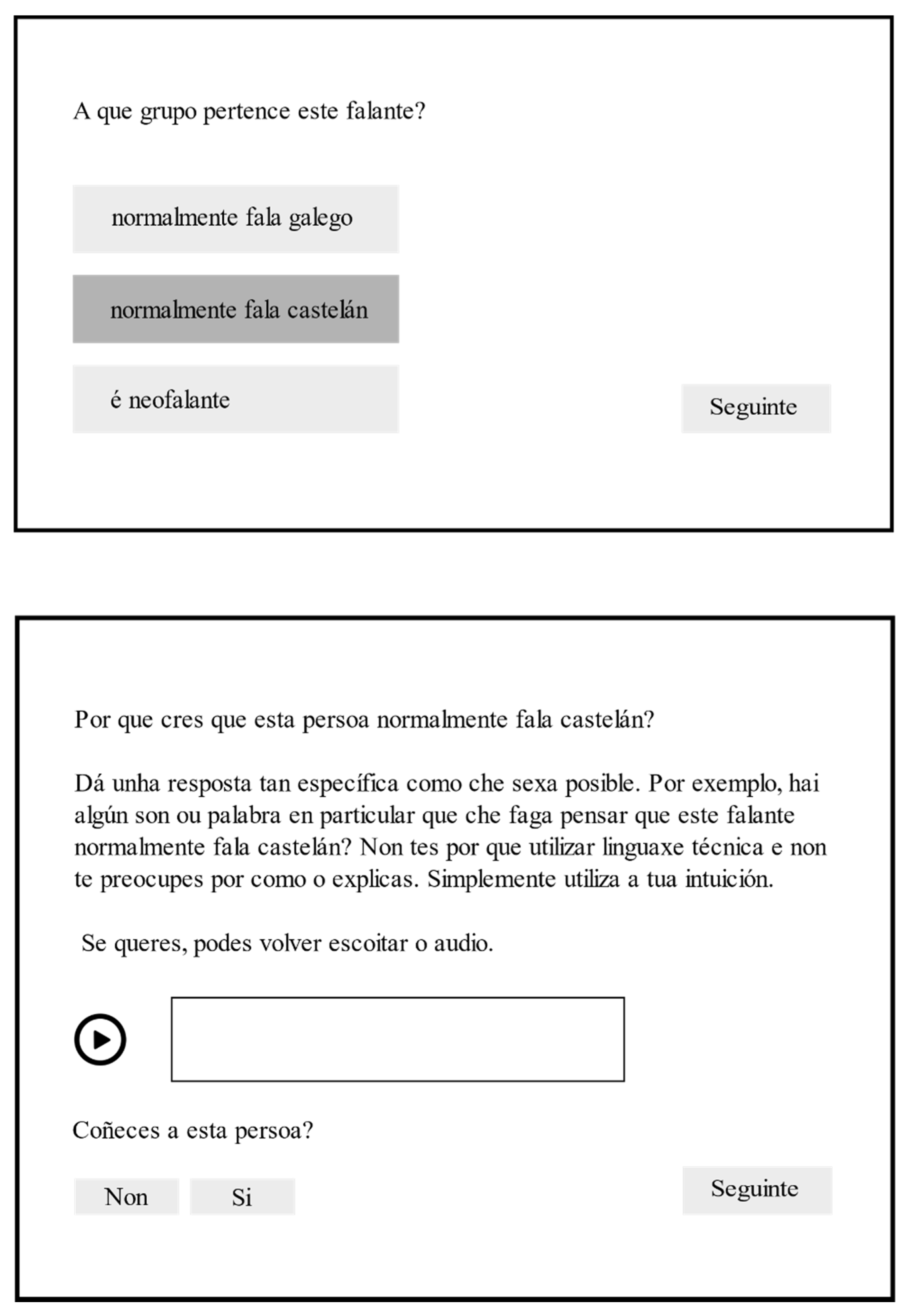
References
- Agha, Asif. 2003. The Social Life of Cultural Value. Language and Communication 23: 231–73. [Google Scholar] [CrossRef]
- Aguete Cajiao, Alba. 2019. Vocalismo galego. Motivacións fonolóxicas do cambio. Doctoral thesis, Universidade de Santiago de Compostela, Santiago de Compostela, Spain. [Google Scholar]
- Aguete Cajiao, Alba. 2020. Contacto de linguas e variedade na emerxencia de novos modelos de vocalismo galego. In Variedades lingüísticas en contacto na Península Ibérica. Edited by Francisco Dubert-García, Vitor Míguez and Xulio Sousa. Santiago de Compostela: Consello da Cultura Galega. [Google Scholar] [CrossRef]
- Allen, J. Sean, and Joanne L. Miller. 2004. Listener Sensitivity to Individual Talker Differences in Voice-Onset-Time. The Journal of the Acoustical Society of America 115: 3171–83. [Google Scholar] [CrossRef] [PubMed]
- Amengual, Mark, and Pilar Chamorro. 2015. The Effects of Language Dominance in the Perception and Production of the Galician Mid Vowel Contrasts. Phonetica 72: 207–36. [Google Scholar] [CrossRef] [PubMed] [Green Version]
- Baugh, John. 2000. Racial Identification by Speech. American Speech 75: 362–64. [Google Scholar] [CrossRef]
- Boersma, Paul, and David Weenink. 2015. Praat: Doing Phonetics by Computer [Computer Program]. Version 6.0. Available online: http://www.praat.org/ (accessed on 13 November 2015).
- Bregman, Micah R., and Sarah C. Creel. 2014. Gradient Language Dominance Affects Talker Learning. Cognition 130: 85–95. [Google Scholar] [CrossRef] [Green Version]
- Butler, Joseph, Caroline Floccia, Jeremy Goslin, and Robin Panneton. 2011. Infants’ Discrimination of Familiar and Unfamiliar Accents in Speech. Infancy 16: 392–417. [Google Scholar] [CrossRef] [PubMed] [Green Version]
- Campbell-Kibler, Kathryn. 2011. Intersecting Variables and Perceived Sexual Orientation in Men. American Speech 86: 52–68. [Google Scholar] [CrossRef]
- Clopper, Cynthia G. 2008. Auditory Free Classification: Methods and Analysis. Behavior Research Methods 40: 575–81. [Google Scholar] [CrossRef] [Green Version]
- Clopper, Cynthia G., and Ann R. Bradlow. 2009. Free Classification of American English Dialects by Native and Non-Native Listeners. Journal of Phonetics 37: 436–51. [Google Scholar] [CrossRef] [PubMed] [Green Version]
- Clopper, Cynthia G., and David B. Pisoni. 2004. Homebodies and Army Brats: Some Effects of Early Linguistic Experience and Residential History on Dialect Categorization. Language Variation and Change 16: 31–48. [Google Scholar] [CrossRef] [Green Version]
- Clopper, Cynthia G., and David B. Pisoni. 2006. Effects of Region of Origin and Geographic Mobility on Perceptual Dialect Categorization. Language Variation and Change 18: 193–221. [Google Scholar] [CrossRef] [Green Version]
- Clopper, Cynthia G., and David B. Pisoni. 2007. Free Classification of Regional Dialects of American English. Journal of Phonetics 35: 421–38. [Google Scholar] [CrossRef] [Green Version]
- Costa, James. 2015. New Speakers, New Language: On Being a Legitimate Speaker of a Minority Language in Provence. International Journal of the Sociology of Language 231: 127–45. [Google Scholar] [CrossRef]
- de la Fuente Iglesias, Mónica, and Susana Pérez Castillejo. 2020a. L1 Phonetic Permeability and Phonetic Path towards a Potential Merger The Case of Galician Mid Vowels in Bilingual Production. Linguistic Approaches to Bilingualism, 1–29. [Google Scholar] [CrossRef]
- de la Fuente Iglesias, Mónica, and Susana Pérez Castillejo. 2020b. Phonetic Interactions in the Bilingual Production of Galician and Spanish /e/ and /o/. International Journal of Bilingualism 24: 305–18. [Google Scholar] [CrossRef]
- Docherty, Gerard J., and Paul Foulkes. 2014. An Evaluation of Usage-Based Approaches to the Modelling of Sociophonetic Variability. Lingua 142: 42–56. [Google Scholar] [CrossRef]
- Drager, Katie, and M. Joelle Kirtley. 2016. Awareness, Salience, and Stereotypes in Exemplar-Based Models of Speech Production and Perception. In Awareness and Control in Sociolinguistic Research. Edited by Anna M. Babel. Cambridge: Cambridge University Press, pp. 1–24. [Google Scholar] [CrossRef] [Green Version]
- Dubert García, Francisco. 2002. Os sociolectos galegos. Cadernos de lingua 24: 5–27. [Google Scholar]
- Eckert, Penelope. 2008. Variation and the Indexical Field. Journal of Sociolinguistics 12: 453–76. [Google Scholar] [CrossRef]
- Evans, Bronwen G., and Gisela Tomé Lourido. 2019. Effects of Language Background on the Development of Sociolinguistic Awareness: The Perception of Accent Variation in Monolingual and Multilingual 5: The 7-Year-Old Children. Phonetica 76: 142–62. [Google Scholar] [CrossRef] [PubMed] [Green Version]
- Fernández Rei, Elisa. 2005. O estándar prosódico. In Norma lingüística e variación. Edited by Rosario Álvarez and Henrique Monteagudo. Santiago de Compostela: Consello da Cultura Galega and Instituto da Lingua Galega, pp. 97–125. [Google Scholar]
- Fernández Rei, Elisa. 2016. Dialect, Historical and Sociolinguistic Aspects of Galician Intonation. Dialectologia 6: 147–69. [Google Scholar]
- Fernández Rei, Elisa, Lurdes de Castro Moutinho, and Rosa Lídia Coimbra. 2014. As entoacións galega e portuguesa: A fronteira á luz da dialectometría e da percepción. In Lingua e identidade na fronteira galego-portuguesa. Edited by Xulio Sousa, Marta Negro Romero and Rosario Álvarez. Santiago de Compostela: Consello da Cultura Galega, pp. 115–41. [Google Scholar]
- Fleming, David, Bruno L. Giordano, Roberto Caldara, and Pascal Belin. 2014. A Language-Familiarity Effect for Speaker Discrimination without Comprehension. Proceedings of the National Academy of Sciences 111: 13795–98. [Google Scholar] [CrossRef] [PubMed] [Green Version]
- Floccia, Caroline, Joseph Butler, Frédérique Girard, and Jeremy Goslin. 2009. Categorization of Regional and Foreign Accent in 5- to 7-Year-Old British Children. International Journal of Behavioral Development 33: 366–75. [Google Scholar] [CrossRef] [Green Version]
- Fox, John, and Sanford Weisberg. 2011. An R Companion to Applied Regression, 2nd ed. Thousand Oaks: Sage. [Google Scholar]
- Freixeiro Mato, Xosé Ramón. 2006. Gramática da lingua galega I. Fonética e fonoloxía, 2nd ed. Vigo: A Nosa Terra. [Google Scholar]
- Freixeiro Mato, Xosé Ramón. 2014. Lingua oral, calidade da lingua e futuro do galego. In Modelos de lingua e compromiso. Edited by Xosé Manuel Sánchez Rei. A Coruña: Baía Edicións, pp. 13–76. [Google Scholar]
- Giles, Howard. 1970. Evaluative Reactions to Accents. Educational Review 22: 211–27. [Google Scholar] [CrossRef]
- Giles, Howard. 1971a. Ethnocentrism and the Evaluation of Accented Speech. British Journal of Social and Clinical Psychology 10: 187–88. [Google Scholar] [CrossRef]
- Giles, Howard. 1971b. Patterns of Evaluation to R.P., South Welsh and Somerset Accented Speech. British Journal of Social and Clinical Psychology 10: 280–81. [Google Scholar] [CrossRef] [PubMed]
- Giles, Howard, and Peter F. Powesland. 1975. Speech Style and Social Evaluation. London and New York: Academic Press. [Google Scholar]
- Girard, Frédérique, Caroline Floccia, and Jeremy Goslin. 2008. Perception and Awareness of Accents in Young Children. British Journal of Developmental Psychology 26: 409–33. [Google Scholar] [CrossRef] [Green Version]
- Goggin, Judith P., Charles P. Thompson, Gerhard Strube, and Liza R. Simental. 1991. The Role of Language Familiarity in Voice Identification. Memory & Cognition 19: 448–58. [Google Scholar] [CrossRef]
- Goldinger, Stephen D. 1998. Echoes of Echoes? An Episodic Theory of Lexical Access. Psychological Review 105: 251–79. [Google Scholar] [CrossRef]
- González González, Manuel. 2008. O novo galego urbano. In Cada palabra pesaba, cada palabra medía. Homenaxe a Antón Santamarina. Edited by Mercedes Brea, Francisco Fernández Rei and Xosé Luís Regueira. Santiago de Compostela: Universidade de Santiago de Compostela, pp. 363–74. [Google Scholar]
- Hornsby, Michael. 2005. Néo-Breton and Questions of Authenticity. Estudios de Sociolinguistica 6: 191–218. [Google Scholar] [CrossRef]
- Hornsby, Michael. 2009. Globalisation Processes and Minority Languages: Linguistic Hybridity in Brittany. Doctoral thesis, University of Southampton, Southampton, UK. [Google Scholar]
- Hornsby, Michael. 2015. The “new” and “traditional” Speaker Dichotomy: Bridging the Gap. International Journal of the Sociology of Language 231: 107–25. [Google Scholar] [CrossRef]
- Iverson, Paul, Patricia K. Kuhl, Reiko Akahane-Yamada, Eugen Diesch, Yoh’ich Tohkura, Andreas Kettermann, and Claudia Siebert. 2003. A Perceptual Interference Account of Acquisition Difficulties for Non-Native Phonemes. Cognition 87: 47–57. [Google Scholar] [CrossRef]
- Jaeger, T. Florian, and Kodi Weatherholtz. 2016. What the Heck Is Salience? How Predictive Language Processing Contributes to Sociolinguistic Perception. Frontiers in Psychology 7: 1–5. [Google Scholar] [CrossRef] [Green Version]
- Jaffe, Alexandra. 2015. Defining the New Speaker: Theoretical Perspectives and Learner Trajectories. International Journal of the Sociology of Language 231: 21–44. [Google Scholar] [CrossRef]
- Johnson, Elizabeth K., Ellen Westrek, Thierry Nazzi, and Anne Cutler. 2011. Infant Ability to Tell Voices Apart Rests on Language Experience. Developmental Science 14: 1002–11. [Google Scholar] [CrossRef] [PubMed]
- Johnson, Elizabeth K., Laurence Bruggeman, and Anne Cutler. 2018. Abstraction and the (Misnamed) Language Familiarity Effect. Cognitive Science 42: 633–45. [Google Scholar] [CrossRef] [PubMed] [Green Version]
- Johnstone, Barbara, and Scott F. Kiesling. 2008. Indexicality and Experience: Exploring the Meanings of /Aw/-Monophthongization in Pittsburgh. Journal of Sociolinguistics 12: 5–33. [Google Scholar] [CrossRef]
- Johnstone, Barbara, Jennifer Andrus, and Andrew E. Danielson. 2006. Mobility, Indexicality, and the Enregisterment of “Pittsburghese”. Journal of English Linguistics 34: 77–104. [Google Scholar] [CrossRef]
- Jones, Zack, Qingyang Yan, Laura Wagner, and Cynthia G. Clopper. 2017. The Development of Dialect Classification across the Lifespan. Journal of Phonetics 60: 20–37. [Google Scholar] [CrossRef]
- Labov, William. 1972. Sociolinguistic Patterns. Philadelphia: University of Pennsylvania Press. [Google Scholar]
- Labraña Barrero, Sabela. 2009. Las consonantes fricativas de la lengua gallega. Estudios de Fonética Experimental 18: 193–213. [Google Scholar]
- Labraña Barrero, Sabela. 2014. Parámetros acústicos dos sons fricativos da lingua galega. Estudios de Fonética Experimental 23: 203–43. [Google Scholar]
- Lambert, Wallace E., Richard C. Hodgson, Robert C. Gardner, and Samuel Fillenbaum. 1960. Evaluational Reactions to Spoken Languages. The Journal of Abnormal and Social Psychology 60: 44–51. [Google Scholar] [CrossRef] [PubMed]
- Lenth, Russell V. 2016. Least-Squares Means: The R Package lsmeans. Journal of Statistical Software 69: 1–33. [Google Scholar] [CrossRef] [Green Version]
- Levi, Susannah V. 2019. Methodological Considerations for Interpreting the Language Familiarity Effect in Talker Processing. WIREs Cognitive Science 10: 1–15. [Google Scholar] [CrossRef] [PubMed]
- Levon, Erez. 2014. Categories, Stereotypes, and the Linguistic Perception of Sexuality. Language in Society 43: 539–66. [Google Scholar] [CrossRef] [Green Version]
- Mayr, Robert, Laura López-Bueno, Martín Vázquez Fernández, and Gisela Tomé Lourido. 2019. The Role of Early Experience and Continued Language Use in Bilingual Speech Production: A Study of Galician and Spanish Mid Vowels by Galician-Spanish Bilinguals. Journal of Phonetics 72: 1–16. [Google Scholar] [CrossRef]
- Mayr, Robert, Llian Roberts, and Jonathan Morris. 2020. Can You Tell by Their English If They Can Speak Welsh? Accent Perception in a Language Contact Situation. International Journal of Bilingualism 24: 740–66. [Google Scholar] [CrossRef]
- McLeod, Wilson, and Bernadette O’Rourke. 2015. ‘New Speakers’ of Gaelic: Perceptions of Linguistic Authenticity and Appropriateness. Applied Linguistics Review 6: 151–72. [Google Scholar] [CrossRef] [Green Version]
- Montgomery, Chris, and Emma Moore. 2018. Evaluating S(c)Illy Voices: The Effects of Salience, Stereotypes, and Co-Present Language Variables on Real-Time Reactions to Regional Speech. Language 94: 629–61. [Google Scholar] [CrossRef]
- Nance, Claire. 2013. Phonetic Variation, Sound Change, and Identity in Scottish Gaelic. Doctoral Thesis, University of Glasgow, Glasgow, Scotland. [Google Scholar] [CrossRef]
- Nance, Claire. 2015. ‘New’ Scottish Gaelic Speakers in Glasgow: A Phonetic Study of Language Revitalisation. Language in Society 44: 553–79. [Google Scholar] [CrossRef]
- Nance, Claire, Wilson McLeod, Bernadette O’Rourke, and Stuart Dunmore. 2016. Identity, Accent Aim, and Motivation in Second Language Users: New Scottish Gaelic Speakers’ Use of Phonetic Variation. Journal of Sociolinguistics 20: 164–91. [Google Scholar] [CrossRef]
- Nazzi, Thierry, Peter W. Jusczyk, and Elizabeth K. Johnson. 2000. Language Discrimination by English-Learning 5-Month-Olds: Effects of Rhythm and Familiarity. Journal of Memory and Language 43: 1–19. [Google Scholar] [CrossRef] [Green Version]
- Neofalante, O. 2021. Available online: https://twitter.com/unneofalante (accessed on 15 March 2021).
- Niedzielski, Nancy. 1999. The Effect of Social Information on the Perception of Sociolinguistic Variables. Journal of Language and Social Psychology 18: 62–85. [Google Scholar] [CrossRef]
- Nycz, Jennifer. 2016. Awareness and Acquisition of New Dialect Features. In Awareness and Control in Sociolinguistic Research. Edited by Anna M. Babel. Cambridge: Cambridge University Press, pp. 62–79. [Google Scholar] [CrossRef] [Green Version]
- Nygaard, Lynne C., and David B. Pisoni. 1998. Talker-Specific Learning in Speech Perception. Perception and Psychophysics 60: 355–76. [Google Scholar] [CrossRef] [Green Version]
- Ó hIfearnáin, Tadhg. 2015. Sociolinguistic Vitality of Manx after Extreme Language Shift: Authenticity without Traditional Native Speakers. International Journal of the Sociology of Language 231: 45–62. [Google Scholar] [CrossRef]
- O’Rourke, Bernadette, and Fernando Ramallo. 2010. Los nuevos hablantes de lenguas minoritarias: Una comparación entre Irlanda y Galicia. Paper present at the Actas del IX Congreso Internacional de Lingüística General, Valladolid, Spain, June 21–23; pp. 1684–700. [Google Scholar]
- O’Rourke, Bernadette, and Fernando Ramallo. 2011. The Native-Non-Native Dichotomy in Minority Language Contexts: Comparisons between Irish and Galician. Language Problems and Language Planning 35: 139–59. [Google Scholar] [CrossRef]
- O’Rourke, Bernadette, and Fernando Ramallo. 2013a. “A miña variedade é defectuosa”: A lexitimidade social das neofalas. Estudos de lingüística galega 5: 89–103. [Google Scholar]
- O’Rourke, Bernadette, and Fernando Ramallo. 2013b. Competing Ideologies of Linguistic Authority amongst New Speakers in Contemporary Galicia. Language in Society 42: 287–305. [Google Scholar] [CrossRef]
- O’Rourke, Bernadette, and Fernando Ramallo. 2015. Neofalantes as an Active Minority: Understanding Language Practices and Motivations for Change amongst New Speakers of Galician. International Journal of the Sociology of Language 231: 147–65. [Google Scholar] [CrossRef]
- O’Rourke, Bernadette, and John Walsh. 2015. New Speakers of Irish: Shifting Boundaries across Time and Space. International Journal of the Sociology of Language 231: 63–83. [Google Scholar] [CrossRef]
- O’Rourke, Bernadette, Joan Pujolar, and Fernando Ramallo. 2015. New Speakers of Minority Languages: The Challenging Opportunity—Foreword. International Journal of the Sociology of Language 231: 1–20. [Google Scholar] [CrossRef] [Green Version]
- Ortega, Ane, Estibaliz Amorrortu, Jone Goirigolzarri, Jacqueline Urla, and Belen Uranga. 2014. New Basque Speakers: Linguistic Identity and Legitimacy. Digithum 16: 47–58. [Google Scholar] [CrossRef] [Green Version]
- Ortega, Ane, Jacqueline Urla, and Estibaliz Amorrortu. 2015. Linguistic Identity among New Speakers of Basque. International Journal of the Sociology of Language 231: 85–105. [Google Scholar] [CrossRef]
- Pallier, Christophe, Laura Bosch, and Núria Sebastián-Gallés. 1997. A Limit on Behavioral Plasticity in Speech Perception. Cognition 64: B9–B17. [Google Scholar] [CrossRef] [Green Version]
- Perrachione, Tyler K., Stephanie N. Del Tufo, and John D. E. Gabrieli. 2011. Human Voice Recognition Depends on Language Ability. Science 333: 5–8. [Google Scholar] [CrossRef] [Green Version]
- Pharao, Nicolai, Marie Maegaard, Janus Spindler Moller, and Tore Kristiansen. 2014. Indexical Meanings of [S+] among Copenhagen Youth: Social Perception of a Phonetic Variant in Different Prosodic Contexts. Language in Society 43: 1–31. [Google Scholar] [CrossRef] [Green Version]
- Preston, Dennis R. 1986. Five Visions of America. Language in Society 15: 221–40. [Google Scholar] [CrossRef]
- Preston, Dennis R. 1989. Perceptual Dialectology. Providence: Foris Publications. [Google Scholar]
- Preston, Dennis R. 1996. Where the Worst English Is Spoken. In Focus on the USA. Edited by E. W. Schneider. Amsterdam: John Benjamins, pp. 297–360. [Google Scholar]
- Preston, Dennis R. 1999. Handbook of Perceptual Dialectology. Amsterdam: John Benjamins. [Google Scholar]
- Pujolar, Joan, and Maite Puigdevall. 2015. Linguistic Mudes: How to Become a New Speaker in Catalonia. International Journal of the Sociology of Language 231: 167–87. [Google Scholar] [CrossRef]
- Purnell, Thomas, William J. Idsardi, and John Baugh. 1999. Perceptual and Phonetic Experiments on American English Dialect Identification. Journal of Language and Social Psychology 18: 10–30. [Google Scholar] [CrossRef]
- Qualtrics. 2015. Qualtrics. Provo, UT, USA. Available online: http://www.qualtrics.com (accessed on 8 December 2015).
- R Core Team. 2013. R: A Language and Environment for Statistical Computing. Available online: http://www.r-project.org/ (accessed on 8 December 2015).
- Rácz, Péter. 2013. Salience in Sociolinguistics. A Quantitative Approach. Berlin and New York: De Gruyter Mouton. [Google Scholar]
- Ramallo, Fernando. 2010. Cara a unha tipoloxía sociolingüística dos falantes de galego. In Educación e linguas en Galicia. Edited by Bieito Silva Valdivia, Xesús Rodríguez Rodríguez and Isabel Vaquero Quintela. Santiago de Compostela: Universidade de Santiago de Compostela, pp. 15–37. [Google Scholar] [CrossRef]
- Ramallo, Fernando. 2013. Neofalantismo. In Contacto de linguas, hibrididade, cambio: Contextos, procesos e consecuencias. Edited by Eva Gugenberger, Henrique Monteagudo and Gabriel Rei-Doval. Santiago de Compostela: Consello da Cultura Galega and Instituto da Lingua Galega, pp. 245–58. [Google Scholar]
- Ramallo, Fernando, and Bernadette O’Rourke. 2014. Perfiles de neohablantes de gallego. Digithum 16: 98–105. [Google Scholar]
- Regueira, Xosé Luís. 1999a. Estándar oral e variación social da lingua galega. In Cinguidos por unha arela común: Homenaxe ó profesor Xesús Alonso Montero. Edited by Rosario Álvarez Blanco and Dolores Vilavedra Fernández. Santiago de Compostela: Universidade, pp. 855–75. [Google Scholar]
- Regueira, Xosé Luís. 1999b. Galician. Journal of the International Phonetic Association 26: 119–22. [Google Scholar] [CrossRef]
- Regueira, Xosé Luís. 2010. Dicionario de pronuncia da lingua galega. A Coruña: Real Academia Galega. [Google Scholar]
- Regueira, Xosé Luís. 2012. Autenticidade e calidade da lingua: Purismo e planificación lingüística no galego actual. Estudos de lingüística galega 4: 187–201. [Google Scholar] [CrossRef]
- Regueira, Xosé Luís. 2014. Mantenimiento y cambio lingüístico: Fricativas sibilantes en gallego. Revista de Filología Románica 31: 151–68. [Google Scholar] [CrossRef] [Green Version]
- Regueira, Xosé Luís. 2019. Variación fonética, a lingua da esfera pública e estándar oral: Entre a lingüística e a política. Revista Galega de Filoloxía 20: 119–47. [Google Scholar] [CrossRef]
- Regueira, Xosé Luís, and Elisa Fernández Rei. 2020. The Spanish Sound System and Intonation in Contact with Galician. In Spanish Phonetics and Phonology in Contact. Studies from Africa, the Americas, and Spain. Edited by Rajiv Rao. Amsterdam and Philadelphia: John Benjamins Publishing Company, pp. 328–62. [Google Scholar] [CrossRef]
- Regueira, Xosé Luís, and María José Ginzo. 2018. A Cross-Linguistic Study of Voiceless Fricative Sibilants in Galician and European Portuguese. In Romance Phonetics and Phonology. Edited by Mark Gibson and Juana Gil. Oxford: Oxford University Press, pp. 62–76. [Google Scholar] [CrossRef]
- Regueira, Xosé Luís, Francisco Dubert García, Edelmira Parga Valiña, and Xulio C. Sousa Fernández. 1998. Os sons da lingua. Vigo: Edicións Xerais de Galicia. [Google Scholar]
- Robert, Elen. 2009. Accommodating “new” Speakers? An Attitudinal Investigation of L2 Speakers of Welsh in South-East Wales. International Journal of the Sociology of Language 195: 93–116. [Google Scholar] [CrossRef]
- Scharinger, Mathias, Philip J. Monahan, and William J. Idsardi. 2011. You Had Me at “Hello”: Rapid Extraction of Dialect Information from Spoken Words. NeuroImage 56: 2329–38. [Google Scholar] [CrossRef] [PubMed] [Green Version]
- Silverstein, Michael. 2003. Indexical Order and the Dialectics of Sociolinguistic Life. Language and Communication 23: 193–229. [Google Scholar] [CrossRef]
- Strand, Elizabeth A. 1999. Uncovering the Role of Gender Stereotypes in Speech Perception. Journal of Language and Social Psychology 18: 86–100. [Google Scholar] [CrossRef]
- Strand, Elizabeth A., and Keith Johnson. 1996. Gradient and Visual Speaker Normalization in the Perception of Fricatives. In Natural Language Processing and Speech Technology. Results of the 3rd KOVENS Conference, Bielefeld, Germany, October 1996. Edited by Dafydd Gibbon. Berlin: Mouton de Gruyter, pp. 14–26. [Google Scholar] [CrossRef] [Green Version]
- Tan, Ying Ying. 2012. Age as a Factor in Ethnic Accent Identification in Singapore. Journal of Multilingual and Multicultural Development 33: 569–87. [Google Scholar] [CrossRef]
- Thompson, Charles P. 1987. A Language Effect in Voice Identification. Applied Cognitive Psychology 1: 121–31. [Google Scholar] [CrossRef]
- Tomé Lourido, Gisela, and Bronwen G. Evans. 2015. Switching Language Dominance for Ideological Reasons: A Study of Galician New Speakers’ Speech Production and Perception. In Proceedings of the International Congress of Phonetic Sciences. Glasgow: University of Glasgow. [Google Scholar]
- Tomé Lourido, Gisela, and Bronwen G. Evans. 2017. Os neofalantes galegos no contexto europeo: A produción e a percepción da fala. In Cambio lingüístico no galego actual. Edited by Xosé Luís Regueira and Elisa Fernández Rei. Santiago de Compostela: Instituto da Lingua Galega and Consello da Cultura, pp. 99–127. [Google Scholar]
- Tomé Lourido, Gisela, and Bronwen G. Evans. 2019. The Effects of Language Dominance Switch in Bilinguals: Galician New Speakers’ Speech Production and Perception. Bilingualism: Language and Cognition 22: 637–54. [Google Scholar] [CrossRef] [Green Version]
- Tuninetti, Alba, Kateřina Chládková, Varghese Peter, Niels O. Schiller, and Paola Escudero. 2017. When Speaker Identity Is Unavoidable: Neural Processing of Speaker Identity Cues in Natural Speech. Brain and Language 174: 42–49. [Google Scholar] [CrossRef] [PubMed]
- Vidal Figueroa, Tiago. 1997. Estructuras fonéticas de tres dialectos de Vigo. Verba 24: 313–32. [Google Scholar]
- Wagner, Laura, Cynthia G. Clopper, and John H. Pate. 2014. Children’s Perception of Dialect Variation. Journal of Child Language 41: 1062–84. [Google Scholar] [CrossRef] [PubMed] [Green Version]
- Walsh, John, and Bernadette O’Rourke. 2014. Becoming a New Speaker of Irish: Linguistic Mudes throughout the Life Cycle. Digithum 16: 67–74. [Google Scholar] [CrossRef]
- Woolard, Kathryn. 2011. Is There Linguistic Life after High School? Longitudinal Changes in the Bilingual Repertoire in Metropolitan Barcelona. Language in Society 40: 617–48. [Google Scholar] [CrossRef]

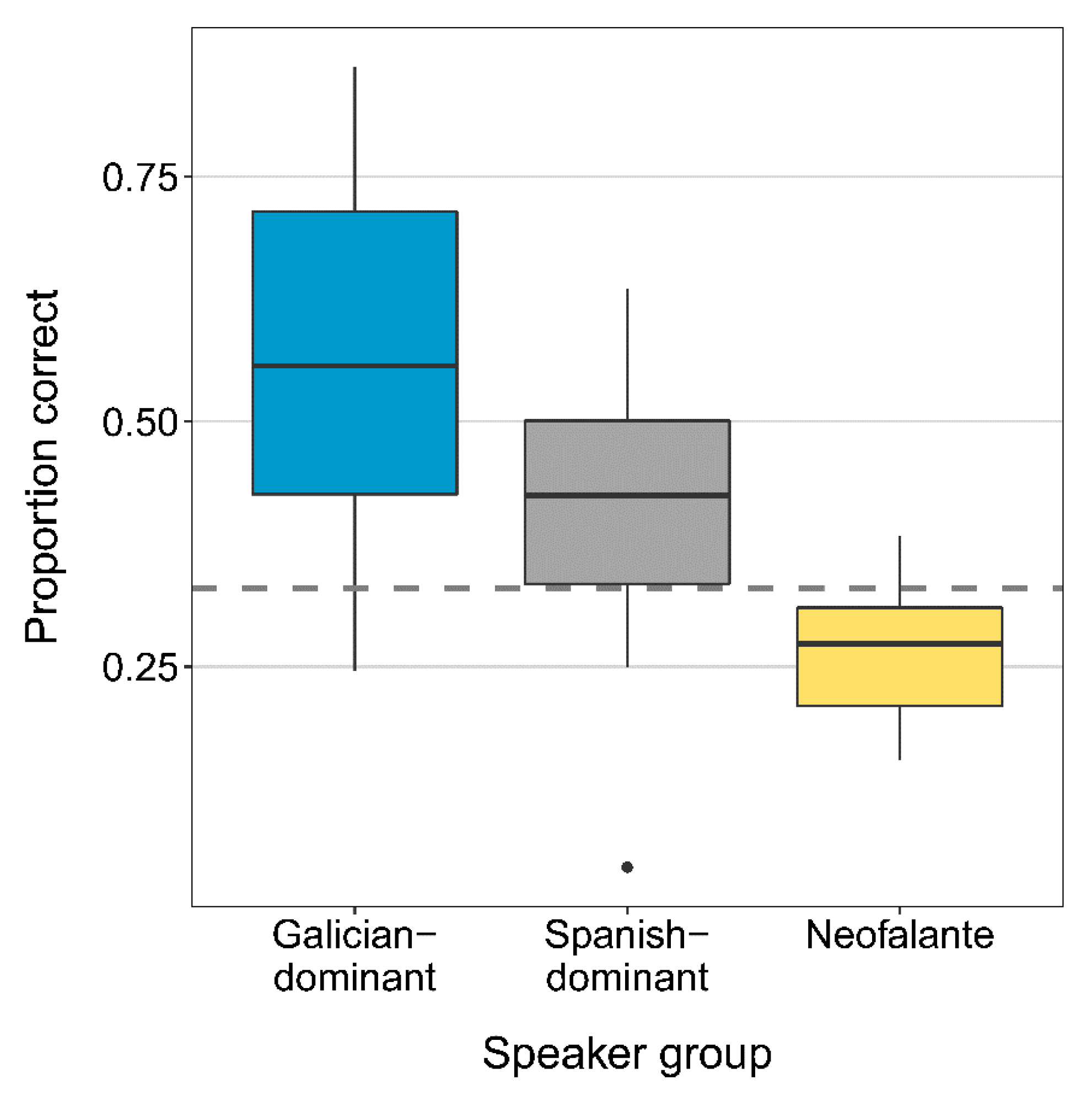
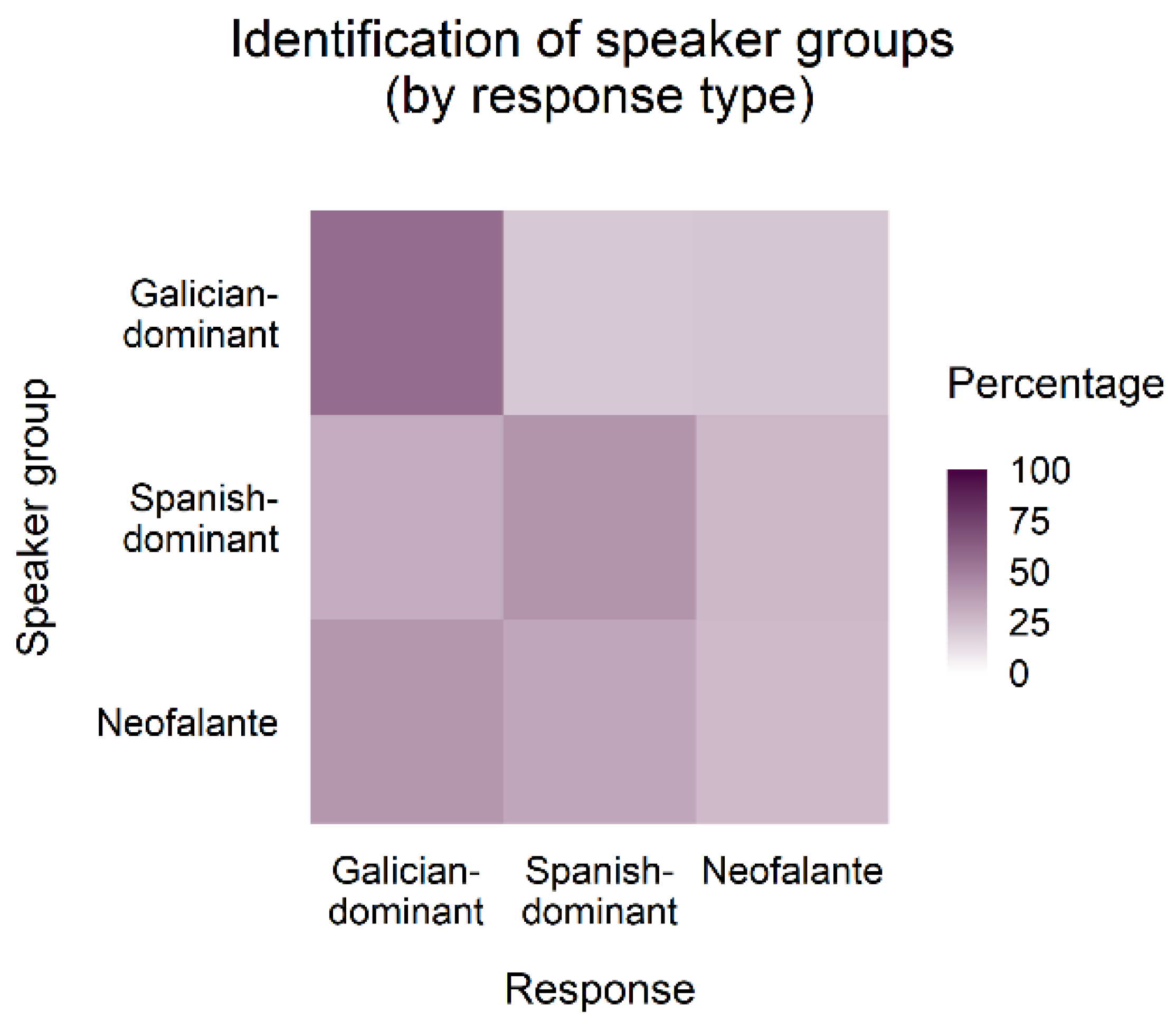
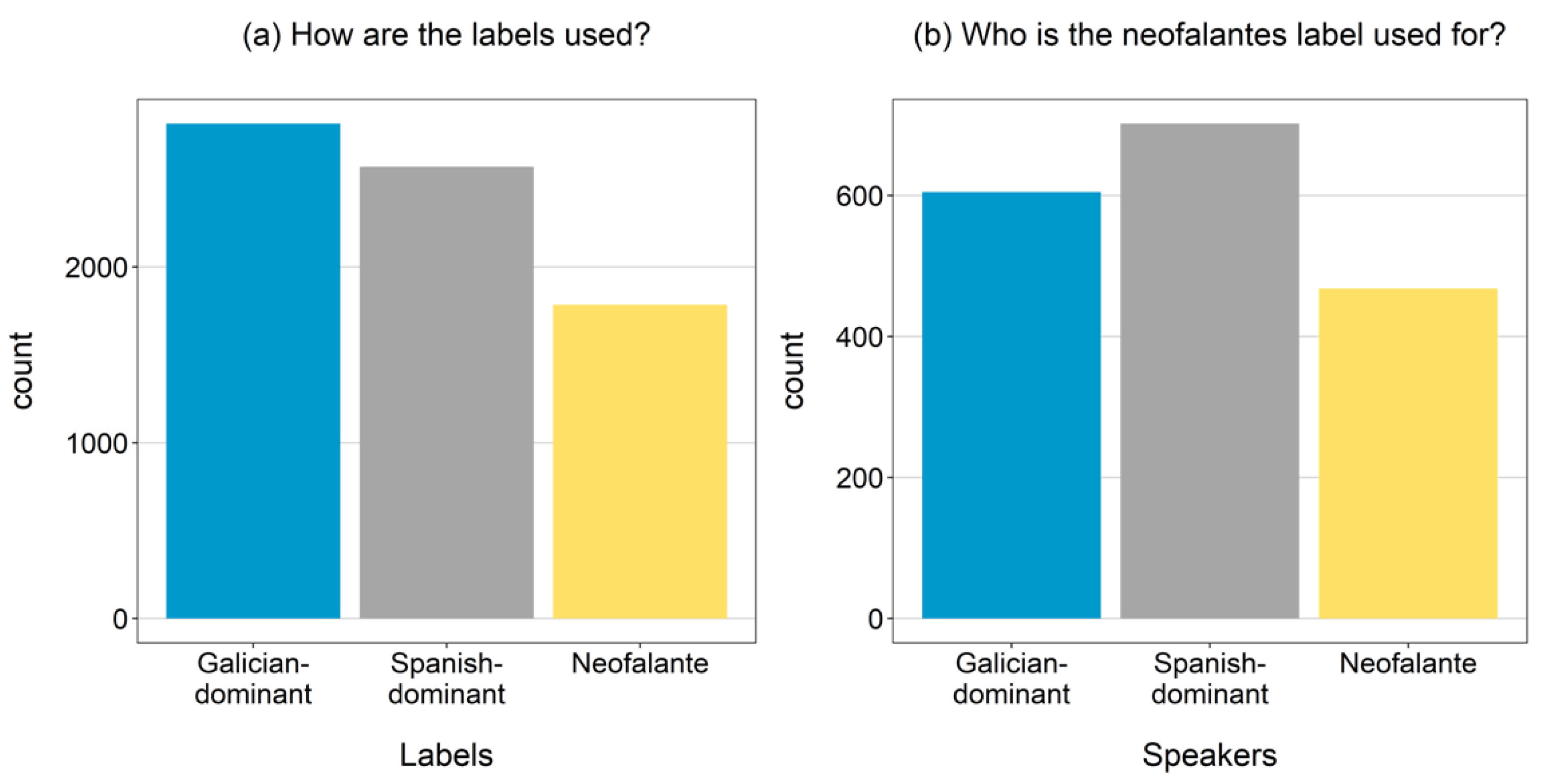
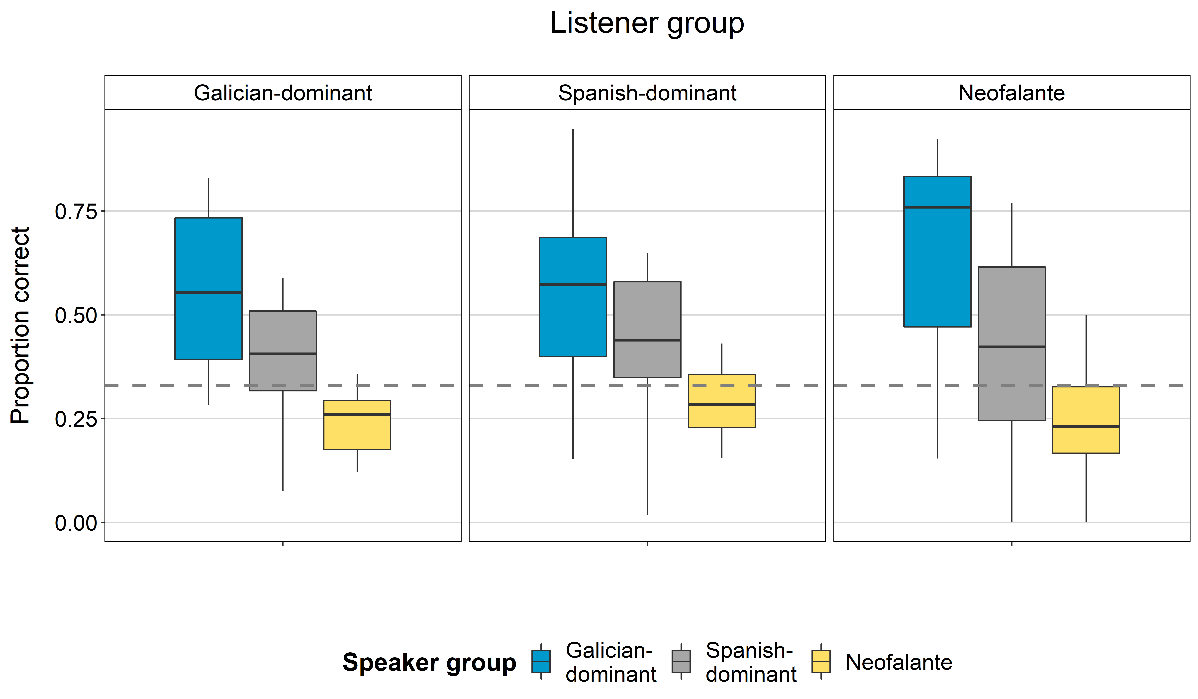
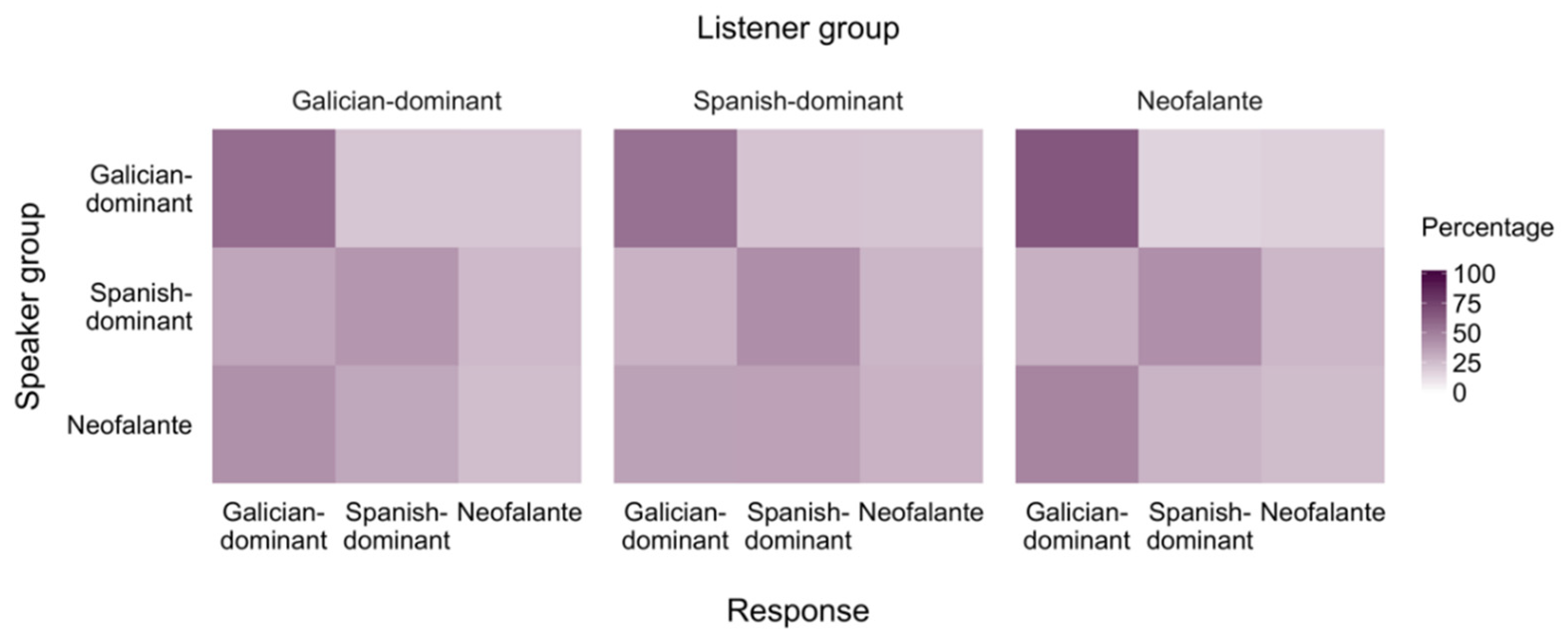
| β | SE | z-Value | p-Value | |
|---|---|---|---|---|
| Model 1: Galician-Dominant Speakers | ||||
| Intercept | −0.659 | 0.096 | −6.839 | <0.001 |
| Real data | 0.965 | 0.057 | 17.046 | <0.001 |
| Model 2: Spanish-Dominant Speakers | ||||
| Intercept | −0.704 | 0.085 | −8.307 | <0.001 |
| Real data | 0.329 | 0.059 | 5.582 | <0.001 |
| Model 3: Neofalantes | ||||
| Intercept | −0.608 | 0.063 | −9.617 | <0.001 |
| Real data | −0.438 | 0.073 | −5.963 | <0.001 |
Publisher’s Note: MDPI stays neutral with regard to jurisdictional claims in published maps and institutional affiliations. |
© 2021 by the authors. Licensee MDPI, Basel, Switzerland. This article is an open access article distributed under the terms and conditions of the Creative Commons Attribution (CC BY) license (http://creativecommons.org/licenses/by/4.0/).
Share and Cite
Tomé Lourido, G.; Evans, B.G. Sociolinguistic Awareness in Galician Bilinguals: Evidence from an Accent Identification Task. Languages 2021, 6, 53. https://0-doi-org.brum.beds.ac.uk/10.3390/languages6010053
Tomé Lourido G, Evans BG. Sociolinguistic Awareness in Galician Bilinguals: Evidence from an Accent Identification Task. Languages. 2021; 6(1):53. https://0-doi-org.brum.beds.ac.uk/10.3390/languages6010053
Chicago/Turabian StyleTomé Lourido, Gisela, and Bronwen G. Evans. 2021. "Sociolinguistic Awareness in Galician Bilinguals: Evidence from an Accent Identification Task" Languages 6, no. 1: 53. https://0-doi-org.brum.beds.ac.uk/10.3390/languages6010053






